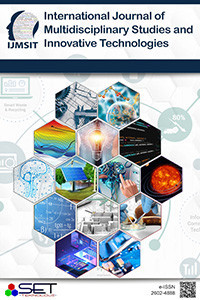Generating Personalized Abstract Art Paintings by using People's Life Energy Distribution
Generating Personalized Abstract Art Paintings by using People's Life Energy Distribution
Data Visualization, Creative Algorithms, Computational Creativity Neural Style Transferring, Abstract Art,
___
- 1. S. Kumari, “What is meant by abstract painting?,” The Statesman, https://www.thestatesman.com/features/meant-abstract-painting-1503052291.html (accessed May 17, 2023)
- 2. Rudolph Arnheim, Visual Thinking, University of California Press, 1969, ISBN 0-520-01871-0
- 3. D. Nimmer, “What is abstract art (and why should I care)?,” Artists Network, https://www.artistsnetwork.com/art-inspiration/what-is-abstract-art/ (accessed May 17, 2023)
- 4. D. E. Knuth, “Computer programming as an art,” Commun. ACM, vol. 17, no. 12, pp. 667–673, Dec. 1974, doi: 10.1145/361604.361612.
- 5. Q. Li, “Data visualization as creative art practice,” Visual Communication, vol. 17, no. 3, pp. 299–312, Aug. 2018, doi: 10.1177/1470357218768202.
- 6. F. B. Viégas and M. Wattenberg, “Artistic Data Visualization: Beyond Visual Analytics,” in Online Communities and Social Computing, D. Schuler, Ed., in Lecture Notes in Computer Science. Berlin, Heidelberg: Springer, 2007, pp. 182–191. doi: 10.1007/978-3-540-73257-0_21.
- 7. S. Alvaro, “Art and Data: the aesthetic emergence of knowledge.” in Proceedings of the 5th Computer Art Congress, 2016, Paris, France, pp. 108-125.
- 8. S. Colton, R. Mántaras, and O. Stock, “Computational Creativity: Coming of Age,” AI Magazine, vol. 30, pp. 11–14, Sep. 2009, doi: 10.1609/aimag.v30i3.2257.
- 9. M. Islam and S. Jin, "An Overview of Data Visualization," 2019 International Conference on Information Science and Communications Technologies (ICISCT), Tashkent, Uzbekistan, 2019, pp. 1-7, doi: 10.1109/ICISCT47635.2019.9012031.
- 10. H. -J. Schulz, "Treevis.net: A Tree Visualization Reference," in IEEE Computer Graphics and Applications, vol. 31, no. 6, pp. 11-15, Nov.-Dec. 2011, doi: 10.1109/MCG.2011.103
- 11. G. A. Pavlopoulos, T. G. Soldatos, A. Barbosa-Silva, and R. Schneider, “A reference guide for tree analysis and visualization,” BioData Mining, vol. 3, no. 1, p. 1, Feb. 2010, doi: 10.1186/1756-0381-3-1.
- 12. L. K. Long, L. C. Hui, G. Y. Fook, and W. M. N. Wan Zainon, “A Study on the Effectiveness of Tree-Maps as Tree Visualization Techniques,” Procedia Computer Science, vol. 124, pp. 108–115, Jan. 2017, doi: 10.1016/j.procs.2017.12.136.
- 13. A. Kobsa, "User Experiments with Tree Visualization Systems," IEEE Symposium on Information Visualization, Austin, TX, USA, 2004, pp. 9-16, doi: 10.1109/INFVIS.2004.70.
- 14. K. Onak and A. Sidiropoulos, “Circular partitions with applications to visualization and embeddings,” in Proceedings of the twenty-fourth annual symposium on Computational geometry, in SCG ’08. New York, NY, USA: Association for Computing Machinery, Jun. 2008, pp. 28–37. doi: 10.1145/1377676.1377683.
- 15. E. Kleiberg, H. van de Wetering and J. J. van Wijk, "Botanical visualization of huge hierarchies," IEEE Symposium on Information Visualization, 2001. INFOVIS 2001., San Diego, CA, USA, 2001, pp. 87-94, doi: 10.1109/INFVIS.2001.963285.
- 16. C. O. Wilke, Fundamentals of Data Visualization a Primer on Making Informative and Compelling Figures. Beijing: O’Reilly, 2019.
- 17. J. Spence, E. Schachter, A. Saleem, and B. Jia, “Increasing Data-Knowledge Through Artistic Representation,” in HCI International 2021 - Posters, C. Stephanidis, M. Antona, and S. Ntoa, Eds., in Communications in Computer and Information Science, vol. 1419. Cham: Springer International Publishing, 2021, pp. 609–624. doi: 10.1007/978-3-030-78635-9_78.
- 18. L. Devroye and P. Kruszewski, “The botanical beauty of random binary trees,” in Graph Drawing, F. J. Brandenburg, Ed., in Lecture Notes in Computer Science. Berlin, Heidelberg: Springer, 1996, pp. 166–177. doi: 10.1007/BFb0021801.
- 19. D. M. de Vienne, “Lifemap: Exploring the Entire Tree of Life,” PLOS Biology, vol. 14, no. 12, p. e2001624, Dec. 2016, doi: 10.1371/journal.pbio.2001624.
- 20. A. Sallaberry, Y.-C. Fu, H.-C. Ho, and K.-L. Ma, “ContactTrees: A Technique for Studying Personal Network Data.” arXiv, Oct. 31, 2014. doi: 10.48550/arXiv.1411.0052.
- 21. S. Laurentiz, “Conformed Thought and the Art of Algorithms,” in Proceedings of the 9th International Conference on Digital and Interactive Arts, in ARTECH 2019. New York, NY, USA: Association for Computing Machinery, Feb. 2020, pp. 1–8. doi: 10.1145/3359852.3359871.
- 22. C.-C. Lin, C.-B. Hsu, J.-C. Lee, C.-H. Chen, T.-M. Tu, and H.-C. Huang, “A Variety of Choice Methods for Image-Based Artistic Rendering,” Applied Sciences, vol. 12, p. 6710, Jul. 2022, doi: 10.3390/app12136710.
- 23. W. Duch, “Computational Creativity,” in The 2006 IEEE International Joint Conference on Neural Network Proceedings, Jul. 2006, pp. 435–442. doi: 10.1109/IJCNN.2006.246714.
- 24. Q. Cai, M. Ma, C. Wang, and H. Li, “Image neural style transfer: A review,” Computers and Electrical Engineering, vol. 108, p. 108723, May 2023, doi: 10.1016/j.compeleceng.2023.108723.
- 25. L. A. Gatys, A. S. Ecker, and M. Bethge, “A Neural Algorithm of Artistic Style.” arXiv, Sep. 02, 2015. doi: 10.48550/arXiv.1508.06576.
- 26. Egan, B. (2018). neural-style-pt (Version 1.0.0) [Computer software]. https://github.com/ProGamerGov/neural-style-pt
- ISSN: 2602-4888
- Yayın Aralığı: Yılda 2 Sayı
- Başlangıç: 2017
- Yayıncı: SET Teknoloji
Melisa GÖZET, Ulaş FİLİZ, Asım Egemen YILMAZ
Hava Lidar ve fotoğraflardan kentsel alanların digital ikizinin oluşturulması ve karşılaştırılması
Generating Personalized Abstract Art Paintings by using People's Life Energy Distribution
Furkan AYAS, Feriştah DALKILIÇ
Modeling Naval Mine Warfare with Machine Learning Algorithms
Hakan AKYOL, Ragıp ZİLCİ, Caner TABAN
Gürgen Ağacı Talaşı Dolgulu Epoksi Matrisli Kompozit Yapıların Mekanik Özelliklerinin İncelenmesi
